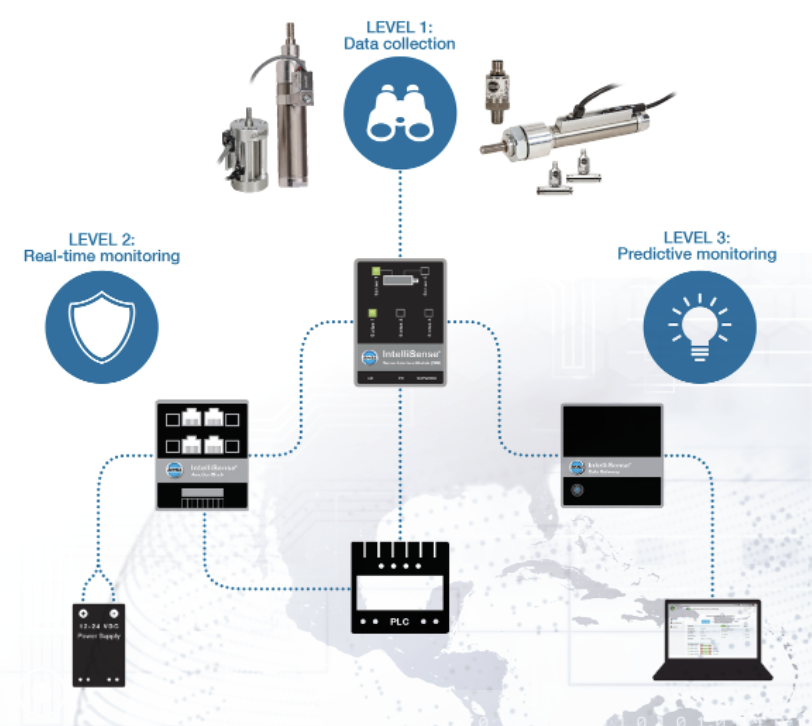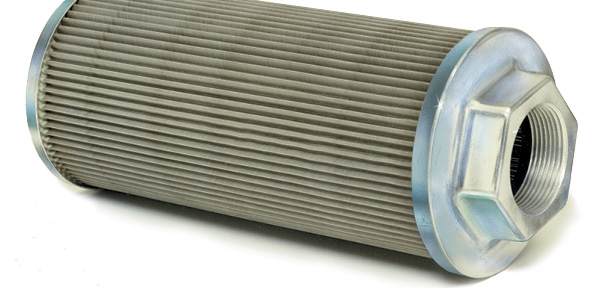Predictive Intelligence and Monitoring Keeps Pneumatic Components Running
By Jeremy King, Product Manager for Vacuum and Sensing, Bimba

For more than a century, workplace managers have pondered and proposed processes to increase productivity. From Taylorism, which applied scientific methods to analyze the most efficient production processes, to lean manufacturing and the Industrial Internet of Things (IIoT), the struggle to meet production targets and reduce downtime has been an ongoing challenge.
A fundamental problem has been that machines running at maximum loads to increase productivity are more likely to break down. These breakdowns affect operational efficiency and severely reduce company profits. Some operations managers have accepted the inevitability of downtime and enable a reactive mode in which they try to figure out what went wrong – after it has already gone wrong. Others have shifted to conducting preventive maintenance by changing components such as cylinders on a regular basis, even when they suspect they’re replacing parts in perfectly good condition. The time and money they devote to these efforts seems tolerable when compared to the possible costs if the components fail, resulting in downtime.
In the last few years, advances in sensing technologies have produced intelligent, small, networkable, embedded devices to dramatically enhance overall equipment effectiveness while shortening production cycles. These sensors report a range of data, such as cylinder condition, stroke time, end-of-travel pressure, and temperatures. Data and insights in real time enable remote monitoring, data logging, and production data monitoring for user analysis. The machine-to-machine technologies allow for close monitoring of individual components, giving users the insight needed to move from emergency repairs to proactive upgrades, optimizing production as a whole.
Solutions for the pneumatic circuit may be understood best by segmenting their functionality into levels of intelligence.

Level 1: Data collection. These basic sensors allow you to generate data to look back at what has happened to a machine. The sensors rely on the user to interpret the data after an event has occurred. With sensors, switches, and transducers delivering raw data from a machine, it is possible for a user to diagnose an issue, but this requires significant experience and expertise around the failure modes of a component.
Level 2: Real-time monitoring. Level 2 sensors take the data generated by level 1 sensors and begin to monitor it in real time. Instead of raw data, preventative maintenance tools analyze the data on the system as a whole and provide feedback about the interaction between components as it occurs. In addition to interpreting the generated data, level 2 sensor systems can provide remote access to the data, allowing users to see what is happening from anywhere in the world at any time. No longer do you need to walk out to the plant floor to check a gauge. Insights into production activities, such as instances where production rates drop, can be easily identified and diagnosed as they happen.
Level 3: Predictive monitoring. Level 3 sensors build on the data and insights of levels 1 and 2 sensors to predict how the machine or component will respond in the future. These predictive algorithms allow users to maximize the use of each component while continuing to avoid downtime. They will be alerted that a component is wearing down before it fails altogether, thereby potentially causing damage to the system, product line, or production schedule. Based on information obtained at the second level, users will be able to identify where there could be issues. Such actionable insights empower machines to actually adapt to maintain maximum efficiency.
Practical implications for fluid power
As users, we crave data. We have unlocked the passageways that lead us to any data we may want. But now we’re inundated. We’ve got information, but we lack the tools to understand it all. We have data, but we need insights.
However, as the growth of IIoT expands the amount of data and insights generated, different users still require different insights. The information needed by the machine designer won’t always help the plant manager, whose understanding may differ from that of the MRO lead or the machine operator.
What these users need are real-time insights; without them, useful results are hard to obtain. Fortunately, the need for precise and accurate performance-related insights has been matched by the emergence of technologies that can ensure reliable component performance and maximum uptime. Here are several outcomes that reflect the levels of functionality described above.
Predictive prognostics. Up-to-date condition information allows hardware to predict when a cylinder will fail, increasing uptime.
Remote monitoring. Using a network of smart devices, users can collect data and monitor machinery remotely, even from multiple locations.
Machine efficiency. With real-time data, users can identify whether a component is achieving its desired performance specification. This is especially important in sequencing applications that rely on precise stroke rates.
Maximizing production. For customers running machinery 24/7 or producing large value batches, advanced sensors can alert users to underperforming components, enabling proactive responses to maximum uptime.
Monitoring regulator settings. Line pressure alerts can be used to monitor regulator and flow control settings, ensuring that operators do not run equipment at the wrong pressure.
Operating the right-sized cylinder. By monitoring air leakage across the cylinder seals, it is possible to determine if the cylinder can be downsized. If excessive leakage is occurring and the cylinder still meets the needs of the application, it may be oversized.
Detecting performance issues. Software featuring real-time monitoring can determine if there is another device on the circuit robbing air from an actuator, which can create inefficiencies and inconsistent production.
Data logging. More advanced data gateways allow users to log up to 100 GB of data on the performance of the cylinder. This data can be exported and applied to generate reports showing how well the cylinder performed for each cycle.
Alerts. Maintenance leads and managers can be notified sooner of changes in performance, facilitating corrective action before the product is ruined.
Cycle-count data. In many applications the number of times a cylinder has been actuated can be directly linked to the number of parts produced. Cycle-count data enables monitoring of the machines’ overall equipment efficiency (OEE).
Monitor dwell time. In a clamp-and-hold application, the amount of time the object is clamped can be critical. A diverter can be added after the clamp operation to separate the suspect product.
Modify machine performance. By monitoring the cycle time of a cylinder, a feedback loop can be created to ensure all subsequent operations remain in sequence.
End-of-travel signal. With end-of-travel outputs, users can be informed when the cylinder stops moving in one direction or the other and, in some situations, eliminate the need for magnetic switches.
With insights obtained from this advanced technology, cylinder design engineers, for example, can confidently recommend modifications to cylinders, such as switching to higher-temperature lubricants or adding rod wipers. Maintenance leads can more reliably schedule maintenance and more accurately document operating conditions. Quality control managers can more precisely monitor force being applied and track dwell time. Operations managers will be in a stronger position to monitor daily production, track average daily cycles, and calculate OEE.
In short, different users value different data. It is critical that the right data is available to the right people at the right time. With ever-evolving technology advances, component manufacturers are turning data into insights, and ultimately optimizing processes and controlling machines to maximize performance of the environment.
Predictive prognostics is benefiting a wide range of industries, including food processing, automotive, pharmaceutical, medical, packaging, and semiconductors. In being able to predict cylinder or valve failure, this technology is identifying when a fluid power component is achieving its desired performance specification. These advances are being leveraged by plant managers for small manufacturers as well as dedicated teams working for Fortune 500 corporations.
We are now in the midst of the next generation of pneumatics. Sensors and monitoring devices focused on pressure-leak detection or energy savings are being enhanced by smart prognostic devices that encompass position, temperature, speed, and pressure leakage. All of this minimizes downtime, thus reducing one of the most frustrating challenges faced by manufacturers today.







